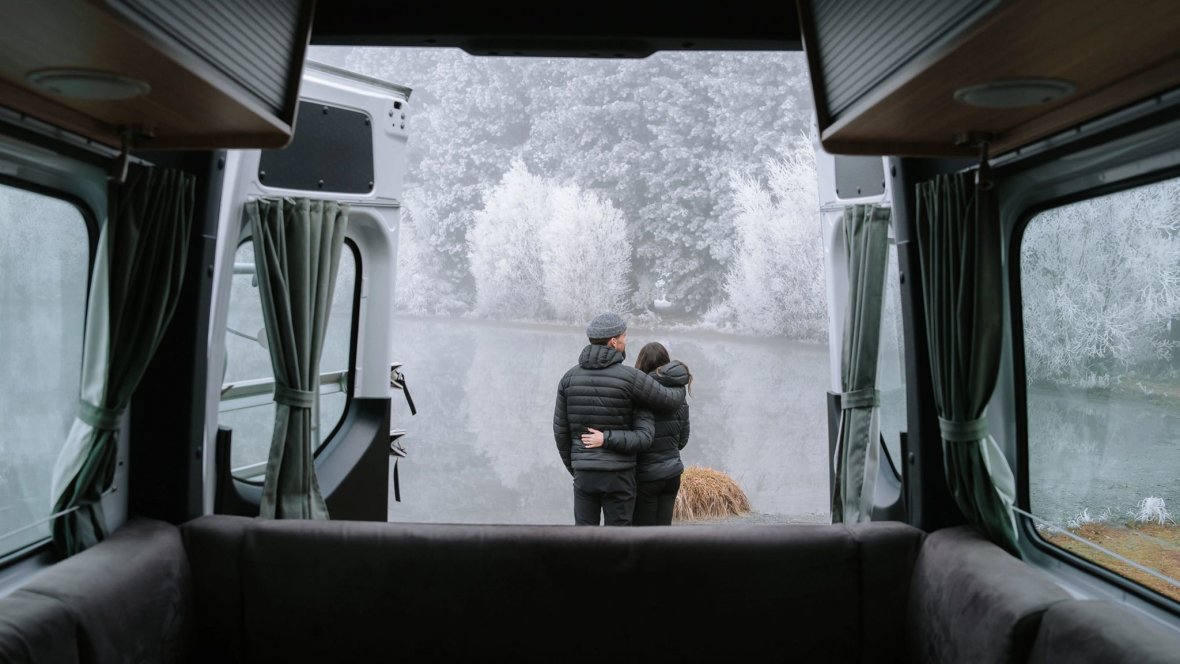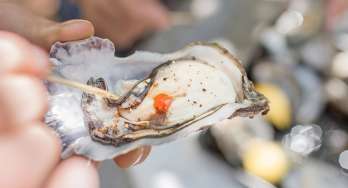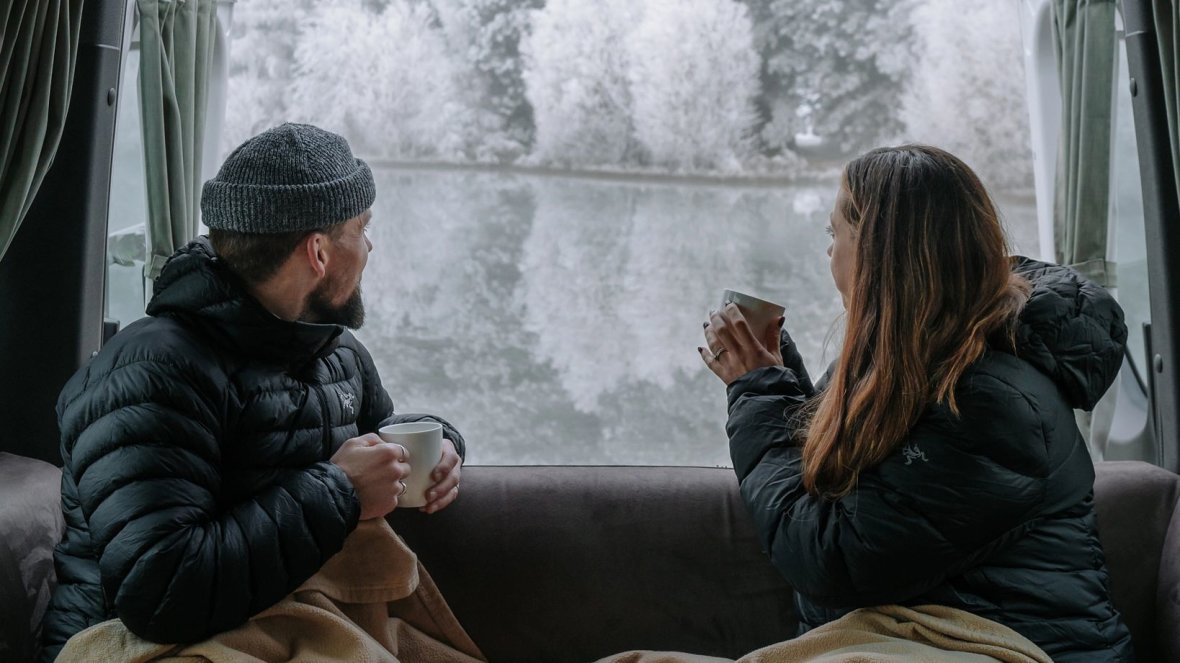Choosing the best motorhome for winter use
Not all campervans are made for winter, and the last thing you want is a cold, damp van. That’s why I always go with a maui motorhome – they’re designed for all seasons and come with everything needed for a warm, comfortable trip.
Here’s what to look for in a winter-ready camper:
-
Insulation and double-glazed windows – Keeps the heat in and the cold out.
-
Built-in heating system – Diesel or gas-powered, so you stay warm even when not plugged into mains power.
-
Blackout curtains and weather seals – Helps trap warmth and prevent drafts.
-
Good ventilation – Reduces condensation and stops bedding from getting damp.
-
All-weather tyres and traction control – Essential for winter roads, especially in alpine areas.
-
Enough space inside – Being stuck indoors on a rainy day is much nicer when you’re not cramped.
I also like to check what’s included – maui provides quality bedding, kitchen gear, and other essentials, which saves packing extra. The right motorhome makes all the difference in winter, turning a cold trip into a cosy, stress-free experience.
My essential packing list for a warm & comfortable trip
When you’re taking a winter campervan road trip, the right gear makes a huge difference. Over the years, I’ve fine-tuned my packing list to include everything needed for a stress-free winter road trip.
Clothing and personal gear
Layering is key. Temperatures can change quickly, so it’s best to dress in layers that trap warmth but can be adjusted throughout the day. I always pack:
-
Merino wool base layers – warm, breathable, and great at regulating temperature.
-
Fleece mid-layers – lightweight but insulating.
-
A good waterproof outer layer – essential for staying dry in wet or snowy conditions.
-
Thermal socks, gloves, beanies, and scarves – cold hands and feet are the fastest way to feel miserable.
Motorhome accessories
One of the best things about hiring a maui motorhome is bedding is included as standard. And if you think you’ll need it, you can add an extra duvet for an additional fee.
A portable space heater is also available as an add-on, which can be handy for extra warmth when you’re plugged into mains power at a campsite. But my favourite cold-weather essential? A simple hot water bottle. It doesn’t take up much room, costs next to nothing, and is one of the most effective ways to stay warm. I fill mine up before bed, tuck it under the blankets, and it stays warm for hours – absolute game changer.
With the right gear, winter campervan trips are not only comfortable but genuinely enjoyable. A warm van, good food, and the right clothing mean you can focus on soaking up the experience – not shivering through it.
Food & drinks
A warm meal or drink can be the best thing after a day out in winter weather. I always stock up on:
-
Hot drink essentials – coffee, tea, hot chocolate, and a good thermos flask to keep drinks warm on the go.
-
Easy-to-warm meals – soups, stews, and instant porridge are great for quick, hearty meals.
-
Non-perishable essentials – having a stash of canned goods, pasta, and snacks is always useful, especially for days when you’re camping away from supermarkets.
Top winter driving tips for safe travel
Driving in winter takes a little more care, especially on New Zealand’s winding roads. Here are a few things I always keep in mind when hitting the road in colder conditions.
Take it slow and steady
Winter driving isn’t about rushing from A to B. Wet or icy roads mean longer stopping distances, so I always give myself extra space from the vehicle in front and take corners more gently than I normally would. If conditions are bad, slowing down is the safest approach – plus, it gives you more time to enjoy the scenery.
Keep your battery fully charged
Cold weather drains batteries faster, so it’s a good idea to stay at powered campgrounds rather than relying on freedom camping. Plugging in overnight helps keep the battery topped up, which means you won’t run into issues starting the engine in the morning.
Be mindful of black ice
Black ice is one of the biggest hazards on winter roads. It’s hard to see and often forms in shaded areas where the sun doesn’t reach, like under trees or on the south-facing side of hills. I try to plan my driving time to avoid times when it’s most likely – early in the morning and late in the afternoon when temperatures are at their lowest.
Avoid sudden braking or acceleration
Smooth, steady driving is key in winter. Slamming on the brakes or accelerating too quickly can cause the tyres to lose grip, especially on wet or icy roads. I always ease into braking and acceleration to keep the motorhome stable.
Pull over and let others pass
If you notice a line of cars behind you, it’s good road etiquette to pull over at the next safe spot and let them pass. This helps keep the flow of traffic moving and takes the pressure off if you prefer driving at a slower pace.
Take regular breaks
Winter driving can be more tiring than in summer. Bad weather, poor visibility, and longer periods of concentration all take a toll. I try to avoid long stretches behind the wheel and make a point of stopping regularly – even just a quick stretch or a coffee break makes a big difference.
Check your tyres before setting off
Maui will make sure your tyres are in great condition when you pick up your motorhome, but it’s always worth double-checking before you hit the road each day. If you spot a puncture or a tyre looks underinflated, sort it before you drive – it’s much easier to deal with in a town than on the side of a remote highway.
Watch for changing weather conditions
New Zealand’s weather can turn quickly, especially in winter. A blue-sky morning doesn’t always mean a clear afternoon, so I always check the forecast before heading off. If high winds, snow, or heavy rain are expected, I adjust my plans and avoid driving through affected areas if possible.
Plan your driving around daylight hours
Winter means shorter days, and driving in the dark – especially in unfamiliar areas – isn’t always fun. I try to plan my driving so I reach my destination before sunset, which also gives me time to settle in and get the motorhome set up while there’s still daylight.

Pre-trip to-do list for guests
A little preparation before your trip can make all the difference once you're on the road. Here are a few things I always do to make sure everything goes smoothly.
-
Check your flight arrival time – Make sure you land with enough time to get to the rental branch before it closes. The last thing you want after a long flight is to be rushing to pick up your motorhome.
-
Download the thl Roadtrip app – This handy app is packed with helpful info, including campsite locations, dump stations, and safety tips. Mobile coverage can be patchy in remote areas, so having maps downloaded in advance is a lifesaver when you need directions.
-
Check weather warnings and road closures – Winter weather can be unpredictable, so I always check for updates before setting off. If snow, heavy rain, or high winds are forecast, I adjust my route or allow extra time.
-
Make a rough itinerary – You don’t need to plan every detail but having a general idea of where you’ll be each night helps, especially when booking powered campsites in popular spots.
-
Stock up on essentials before you leave town – Supermarkets and fuel stations can be few and far between in some areas, so I always make sure I have enough food, water, and fuel before heading off into more remote regions.
Best scenic winter routes
Whether you’re soaking in hot pools, driving through snowy mountain passes, or exploring geothermal wonders, winter adds a whole new dimension to the journey. Here are some of maui’s travel itineraries perfect for a winter motorhome trip.
Thermal Explorer Highway
If you love hot pools and geothermal landscapes, the Thermal Explorer Highway is a must. This route takes you from Auckland to Hawke’s Bay, passing through Rotorua, Taupō, and Tongariro National Park. Expect bubbling mud pools, steaming geysers, and natural hot springs – perfect for warming up after a chilly day exploring.
14-day North Island motorhome itinerary
If you’re looking for a longer winter road trip, the 14-day North Island motorhome itinerary covers a huge variety of landscapes – from the forests of Northland to the volcanic terrain of Tongariro. This route includes everything from cultural sites to scenic hikes, making it a great option if you want to see as much of the North Island as possible.
Breathtaking South Island winter road trip
If you want classic South Island winter scenery, this Breathtaking Winter Road Trip is perfect. It starts in Queenstown and takes you through Wānaka, Te Anau, the Catlins, and up the rugged West Coast. Expect snow-covered peaks, dramatic coastal views, and plenty of opportunities for winter activities, from scenic flights over the glaciers to soaking in hot pools in Franz Josef.
Inland Scenic Route 72
For a quieter South Island road trip, Inland Scenic Route 72 is a great alternative to the busy highways. This route runs along the foothills of the Southern Alps, taking you through small towns, ski fields, and scenic walking tracks. It’s perfect if you enjoy winter hikes, fishing, or just soaking in the mountain views without the crowds.
Finding the best winter-friendly campsites
A good campsite makes all the difference in winter. While freedom camping can be great in summer, colder weather means having access to powered sites, heated communal areas, and drying rooms is a huge plus. After a long day exploring, there’s nothing better than plugging in the heater, warming up in a cosy lounge, or drying off wet gear properly.
Some of my go-to winter-friendly campsites are:
-
Rotorua Thermal Holiday Park – A great option in the North Island, this park has its own mineral hot pools – perfect for warming up after a day out in the geothermal parks.
-
Taupō DeBretts Spa Resort – A fantastic winter stop with powered sites and access to natural hot pools, plus a drying room for wet gear after a chilly day by the lake.
-
Lake Tekapo Holiday Park – Right on the edge of Lake Tekapo, this park has powered sites and access to Tekapo Springs, where you can soak in hot pools with mountain views.
-
Queenstown Top 10 Holiday Park – Just outside Queenstown, this park has heated communal spaces and a free shuttle into town, making it easy to explore without worrying about parking.

My hacks for keeping your motorhome warm & dry
A warm, dry camper makes all the difference on a winter road trip. Even with built-in heating, it’s worth knowing a few tricks to keep the chill out and prevent condensation from turning your cosy setup into a damp one. Here are some things I always do to stay comfortable on the road.
-
Park strategically for sun exposure – If there’s morning sun, I make sure the windscreen is facing it to warm up the camper naturally. In the afternoon, parking in a sheltered spot can help block cold winds.
-
Ventilate – Close all vents and windows once the sun goes down to trap heat inside, especially on frosty nights, but ventilate during the day to reduce moisture build-up. Opening windows or vents for a bit each morning helps prevent condensation, especially after cooking or showering.
-
Wipe down windows if they fog up – A quick wipe in the morning stops condensation from turning into lingering dampness.
-
Keep wet gear out of the living area – If I’ve been caught in the rain, I try to dry jackets and boots in the campsite’s drying room rather than inside the motorhome.
Fun & cosy activities on your winter road trip
One of the best things about winter road trips is the slower pace. Shorter days and cooler temperatures mean more time for relaxed, cosy activities – both inside the camper and out in nature. Whether the weather keeps you indoors or you’re wrapped up exploring, there are plenty of ways to make the most of the season.
Cosy nights in the camper
Some of my favourite winter road trip memories are the simple ones – usually curled up in the camper with a hot drink while the rain taps on the roof! If you’re spending an evening inside, it’s the perfect chance to:
-
Play a board game or card game (I always bring a pack of cards – takes up no space and is great for nights in).
-
Get stuck into a good book with a blanket and a hot water bottle.
-
Have a movie night – download some shows and movies on your device before you hit the road.
-
Cook something hearty like a stew or a hot dessert – there’s something satisfying about a warm meal on a cold night.
Outdoor winter highlights
Winter might be colder, but it also brings some of the best outdoor experiences in New Zealand. Some of my must-do winter activities include:
-
Stargazing in the Aoraki Mackenzie Dark Sky Reserve – On a clear night, this is one of the best places in the world to see the stars. The air is crisp, the skies are dark, and the Milky Way is unbelievably bright.
-
Relaxing in natural hot pools – There’s nothing better than sinking into warm water when it’s cold outside. Hanmer Springs and Tekapo Springs are two of my favourites.
-
Winter hikes with snowy landscapes – Some trails are even more beautiful in winter. The Hooker Valley Track near Aoraki Mt Cook is stunning with snow-covered peaks, and the Taranaki Falls Track in Tongariro National Park often has icy waterfalls in the colder months.
Ready for a winter campervan adventure?
Whether it’s soaking in hot pools, hiking through alpine landscapes, or simply enjoying a quiet night in the camper with a warm meal, winter brings a whole new way to experience New Zealand. If you’ve never taken a cold-season road trip before, now’s the time to give it a go.
Start your campervan adventure today. Book your maui motorhome and explore New Zealand on your terms.




